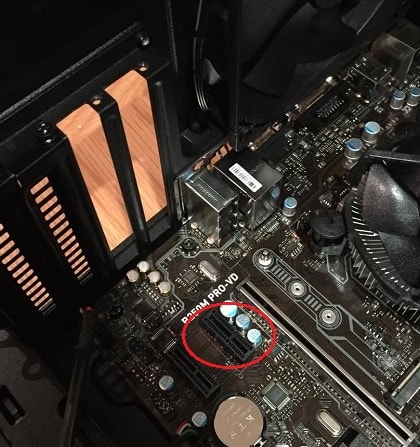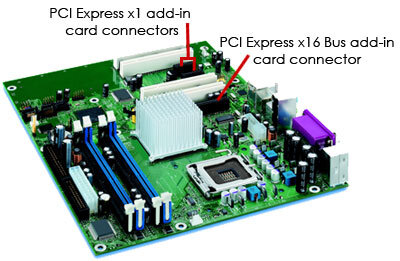X16 Graphics Slot Mean
Peripheral Component Interconnect (PCI) Express (PCIe) is a scalable Input/Output (I/O) serial bus technology that largely replaced earlier PCI slots on motherboards. It is a port that allows certain internal components to be installed into a computer. In 2004, PCI Express slots began appearing alongside standard slots, starting a gradual transition to the new technology. While some standard PCI slots can still be found on motherboards, many computer users prefer PCI express for graphics cards and other components.

Which means if your computer motherboard has an open x1 Slot as shown in the example picture, then you can install any x4, x8 or even a x16 Graphics Card into the x1 PCIe Slot. The expansion card will work just fine, but the speed of communication is limited to the single lane. You can insert a PCIe x1 card into a PCIe x16 slot, but that card will receive less bandwidth. Similarly, you can insert a PCIe x8 card into a PCIe x4 slot, but it’ll only work with half the.
The Purpose of PCI Express
PCIe slots are found on many motherboards, letting computer users install components into them. They allow the motherboard and other software in a computer to access and use devices connected to these slots. While PCIe has been used throughout the first decade of the 21st Century, new slots are likely to replace them at some point in the future.
Benefits of PCIe Technology
PCI Express is a point-to-point connection, which means it does not share bandwidth but communicates directly with devices via a switch that directs data flow. This allows for 'hot swapping' or 'hot plugging,' which means cards in PCIe slots can be changed without shutting down the computer, and they consume less power than previous PCI technology. One of the most promising features of PCIe is that it is scalable, which means greater bandwidth can be achieved through adding more 'lanes.'
PCI Express has several additional advantages, not only to the user but to manufacturers. It can be implemented as a unifying I/O structure for desktops, servers, and workstations, and it is cheaper than PCI standard to implement at the motherboard level. This keeps costs low for the consumer. It is also designed to be compatible with earlier Operating Systems and PCI device drivers.
Types of PCIe Formats


The initial rollout of PCI Express provided three consumer options: x1, x2, and x16. These numbers represents the 'lanes:' x1 has 1 lane; x2 has 2 lanes, and x16 has 16. Each lane is bi-directional and consists of 4 pins. Lanes in PCIe version 1.x had a lower delivery transfer rate, but PCIe 3.0 introduced a transfer rate of 500 megabytes per second (MBps) in each direction for a total of 1,000 MBps, or 1 gigabyte per second (GBps), per lane.
| PCIe | Lanes | Pins | MBps | Purpose |
| x1 | 1 | 4 | 1 GBps | Device |
| x2 | 2 | 8 | 2 GBps | Device |
| x16 | 16 | 64 | 16 GBps | Graphics Card |
PCIe and Graphics Cards
The 16-lane (x16) slot has replaced the Accelerated Graphics Port (AGP) on many motherboards and fits a PCIe graphics card. Boards that include the x1 and x2 slots usually have them for other components, such as sound or networking cards. As computer graphics demands increase, x32 and x64 slots may become available, and future versions of PCIe might improve upon lane data rates.
Other PCI Technologies
Pcie X1 In X16 Slot
PCI Express should not be confused with PCI eXtended (PCI-X), used in the server market. PCI-X improved on standard PCI bus to deliver a maximum bandwidth of 1GBps. PCIe has been developed for the server market as well, initially with the x4, x8 and x12 formats reserved. This far exceeds PCI-X capability.
History of PCI Technology
Intel first introduced PCI technology in the early 1990s to replace the Industry Standard Architecture (ISA) bus. Although robust enough to last over a decade, total available bandwidth of just 133 MBps, shared between slots, meant that high demand devices quickly overwhelmed computer resources. In 1997 this problem was partially alleviated by implementation of a separate AGP slot with dedicated bandwidth. However, as component manufacturers developed many high-demand devices for computers, a new architecture was required, which led to the introduction of PCI Express.
In a previous blog post, we covered the difference between PCI and PCI-X. The response to the post was enthusiastic, and we were asked to write a complementary post explaining the difference between PCIe x1, x4, x8, x16. We are always happy to answer customers’ questions (feel free to contact us with your questions regarding industrial computers).
The short answer is:
- ‘PCIe x1’ connections have one data lane
- ‘PCIe x4’ connections have four data lanes
- ‘PCIe x8’ connections have eight data lanes
- ‘PCIe x16’ connections have sixteen data lanes
The long answer:
The more data lanes in a connection, the more bandwidth between the card and the host. However, there is usually a cost increase incurred with higher lane counts.
PCIe is an updated version of the PCI protocol. Similar to PCI/PCI-X interfaces, PCIe was developed for peripheral component interconnection. PCIe differs from PCI/PCI-X in several ways, but this blog won’t cover most of those differences. However, one key difference will allow us to better understand the differences between the variations of the PCIe protocol (x1, x4, x8, x16 and x32). That key difference is ‘parallel’ versus ‘serial’ data transmission.
In PCI and PCI-X architecture, all of the cards share parallel data lines to and from the host. Differences between card-speeds and slot-types regularly result in throttled data speeds.
In the PCIe architecture, Each card has it’s own dedicated serial data connections (lanes) to the host. This allows each card connection to achieve a bandwidth independent of other cards that may be active in the system. The number of lanes are indicated by the suffix of the PCIe protocol (×1, ×4, ×8, ×16, ×32). Each lane is capable of speeds from 250-1969 MB/s, depending on the version of the PCIe protocol (v1.x, v2.x, v3.0, v4.0).

PCIe cards can always operate in PCIe slots with the same or more lanes than the card. For example, an x8 card can operate in a slot with x8, x16, or x32 lanes. Similarly, an x1 card can operate in any PCIe slot.
Pci Express X16 Slots
caveat:
Pcie X16 Slot
Sometimes, a PCIe slot operates with fewer data lanes than the mechanical slot-type indicates. For example, sometimes a motherboard manufacturer will use an x16 mechanical slot even though the data connection is only x8. In these cases, the higher-bandwidth card still may work (for example, an x16 card in an x16 slot with only x8 connection), if the card doesn’t require that extra bandwidth. The following image shows the PCI connections of the motherboard used in DuroPC’s RAC355. Notice ‘SLOT 1/5’ are PCIe x16 slots but only have an x8 connection. Similarly, notice how ‘SLOT 7’ uses an x8 slot but only has an x4 connection. (Click the image to see a larger version.)